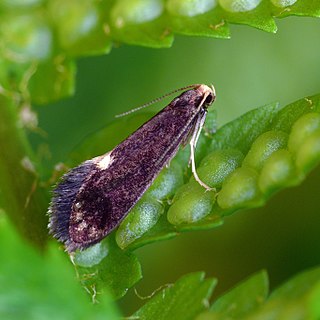
Yellowjacket or yellow jacket is the common name in North America for predatory social wasps of the genera Vespula and Dolichovespula. Members of these genera are known simply as "wasps" in other English-speaking countries. Most of these are black and yellow like the eastern yellowjacket Vespula maculifrons and the aerial yellowjacket Dolichovespula arenaria; some are black and white like the bald-faced hornet, Dolichovespula maculata. Others may have the abdomen background color red instead of black. They can be identified by their distinctive markings, their occurrence only in colonies, and a characteristic, rapid, side-to-side flight pattern prior to landing. All females are capable of stinging. Yellowjackets are important predators of pest insects.

The Batrachedridae are a small family of tiny moths. These are small, slender moths which rest with their wings wrapped tightly around their bodies.

Omiodes continuatalis is a species of moth in the family Crambidae. It is endemic to the Hawaiian islands of Kauai, Oahu, Molokai, Maui, Lanai and Hawaii. It was first cited as possibly extinct by W.C. Gagné and Francis Gard Howarth in 1982. It was listed as extinct by the Hawaiʻi Biological Survey in 2002 and the IUCN in 2003, but was rediscovered later in 2003.
Scotorythra paludicola, the koa looper moth, is a moth of the family Geometridae. It was first described by Arthur Gardiner Butler in 1879. It is endemic to the Hawaiian islands of Kauai, Oahu, Maui and Hawaii.

Hyposmocoma chilonella is a species of moth of the family Cosmopterigidae. It was first described by Lord Walsingham in 1907. It is endemic to the Hawaiian islands of Kauai, Oahu, Maui, Molokai and Hawaii.
Hyposmocoma ekaha is a species of moth of the family Cosmopterigidae. It was first described by Otto Herman Swezey in 1910. It is endemic to the Hawaiian island of Oahu. The type locality is the Halawa Valley.
Thyrocopa abusa is a moth of the family Xyloryctidae. It was first described by Lord Walsingham in 1907. It is endemic to the Hawaiian islands of Kauai, Oahu, Molokai, Lanai, Maui and Hawaii. It is the type species of the genus Thyrocopa.
Batrachedrodes is a genus of moths of the Momphidae family. All species of this genus are endemic to the Hawaiian Islands.
Batrachedrodes bedelliella is a moth of the family Momphidae. It was first described by Lord Walsingham in 1907. It is endemic to the Hawaiian islands. As of 1978, the distribution is not entirely clear. It is thought to be native to Oahu, Molokai, Maui and Hawaii, however only specimens from Maui and Molokai are certainly collected on those islands. The holotype was collected at Haleakala in Maui at 5,000 feet (1,500 m) elevation.
Batrachedrodes ephelus is a moth of the family Momphidae. It was first described by Lord Walsingham in 1907 and is endemic to the Hawaiian island of Molokai.
Batrachedrodes lomentella is a moth of the family Momphidae. It was first described by Lord Walsingham in 1907. It is endemic to the Hawaiian islands of Oahu and Hawaii.
Batrachedrodes supercincta is a moth of the family Momphidae. It was first described by Lord Walsingham in 1907. It is endemic to the Hawaiian island of Maui.
Batrachedrodes syrraphella is a moth of the family Momphidae. It was first described by Lord Walsingham in 1907. It is endemic to the Hawaiian islands of Oahu and Hawaii.
Praeacedes is a monotypic moth genus in the family Tineidae first described by Hans Georg Amsel in 1954. Its only species, Praeacedes atomosella, was first described by Francis Walker in 1863. It has a wide range and has been recorded from Europe, Australia, Hawaii, South America and North America. The species has commonly been misidentified in various parts of the world.

Hellula undalis, the cabbage webworm or Old World webworm, is a moth of the family Crambidae. It is a widespread species which is found from Europe across Asia to the Pacific. It was first described from Italy.
Homoeosoma albosparsum is a moth of the family Pyralidae described by Arthur Gardiner Butler in 1881. It is endemic to the Hawaiian islands of Kauai, Oahu, Maui and Hawaii.

Cryptophlebia illepida is a species of moth in the family Tortricidae that is endemic to the islands of Kauaʻi, Oʻahu, Molokaʻi, Maui, Lānaʻi and Hawaiʻi. Common names include koa seedworm, klu tortricid, koa seed moth, litchi borer, litchi moth, macadamia nut borer and macadamia nut moth. It was first described by Arthur Gardiner Butler in 1882.

Herpetogramma licarsisalis, the grass webworm or tropical grass webworm, is a moth of the family Crambidae. It is native to most of the old world tropics, including New Zealand, Hong Kong and Queensland. It is an introduced species in many other parts of the world, including Hawaii and the Canary Islands.

Psychoides filicivora is a moth of the family Tineidae first described by Edward Meyrick in 1937. First found in Ireland in 1909, it is possible that the moth was introduced from imported ferns from Asia. The moth can be found from spring though autumn in a series of generations. The species overwinters as a larva.

Psychoides verhuella is a moth of the family Tineidae first described by Charles Bruand in 1853.








